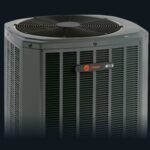A 1-ton air conditioning (AC) unit is a compact cooling system designed to remove 12,000 British Thermal Units (BTUs) of heat per hour from a space. This capacity makes it ideal for cooling areas approximately 400 to 600 square feet in size, such as small apartments, single rooms, or offices.
Understanding the 1-Ton AC Unit
The term “ton” in AC units refers to the amount of heat the system can remove in an hour. Specifically, 1 ton equates to 12,000 BTUs per hour. This measurement originates from the amount of heat required to melt one ton of ice over 24 hours.
Key Features and Specifications
When considering a 1-ton AC unit, it’s essential to evaluate the following aspects:
- Cooling Capacity: Consistently rated at 12,000 BTUs per hour.
- Energy Efficiency: Look for units with high Energy Efficiency Ratio (EER) or Seasonal Energy Efficiency Ratio (SEER) ratings. Higher ratings indicate better energy efficiency, leading to lower electricity consumption.
- Electrical Requirements: Typically operate on standard residential voltages, such as 115V or 230V, depending on the model.
- Dimensions and Weight: Compact and lightweight designs facilitate easier installation and are suitable for limited spaces.
Popular Types of 1-Ton AC Units
There are several configurations available:
- Split Systems: Consist of an indoor unit and an outdoor compressor, offering quiet operation and efficient cooling.
- Window Units: Self-contained systems installed in a window opening, suitable for single-room cooling.
- Portable Units: Freestanding units that can be moved between rooms, requiring minimal installation.
Installation Considerations
Proper installation is crucial for optimal performance:
- Location: Choose a spot with adequate airflow and minimal obstructions.
- Wall Strength: Ensure the mounting surface can support the unit’s weight.
- Spacing: Maintain recommended clearances around the unit for efficient operation.
- Height: Install the indoor unit at an appropriate height to facilitate effective cooling distribution.
For a visual guide on split AC installation, you can refer to the following video:
Energy Consumption and Efficiency
A 1-ton AC unit’s energy consumption varies based on its efficiency rating. For instance, a unit with a SEER rating of 14 consumes approximately 857 watts per hour during operation. Upgrading to a higher SEER-rated unit can result in significant energy savings over time.
Conclusion
A 1-ton AC unit is an excellent choice for cooling small to medium-sized spaces efficiently. By understanding its features, installation requirements, and energy consumption, you can make an informed decision that ensures comfort and cost-effectiveness.
FAQs
1. What size room is suitable for a 1-ton AC unit?
A 1-ton AC unit is ideal for rooms measuring between 400 to 600 square feet, depending on factors like insulation and ceiling height.
2. How much electricity does a 1-ton AC unit consume?
Energy consumption varies with efficiency ratings. For example, a unit with a 14 SEER rating uses about 857 watts per hour.
3. Can I install a 1-ton AC unit myself?
While some portable and window units are designed for DIY installation, it’s recommended to have split systems installed by professionals to ensure proper setup and efficiency.
4. What is the difference between EER and SEER ratings?
EER (Energy Efficiency Ratio) measures efficiency at a specific temperature, while SEER (Seasonal Energy Efficiency Ratio) considers performance over an entire cooling season.
5. How often should I service my 1-ton AC unit?
Regular maintenance, such as cleaning filters and checking refrigerant levels, should be performed every 3-6 months to ensure optimal performance and longevity.










